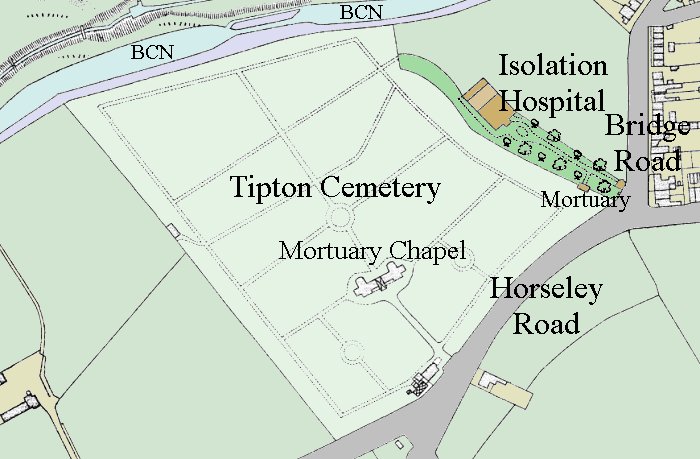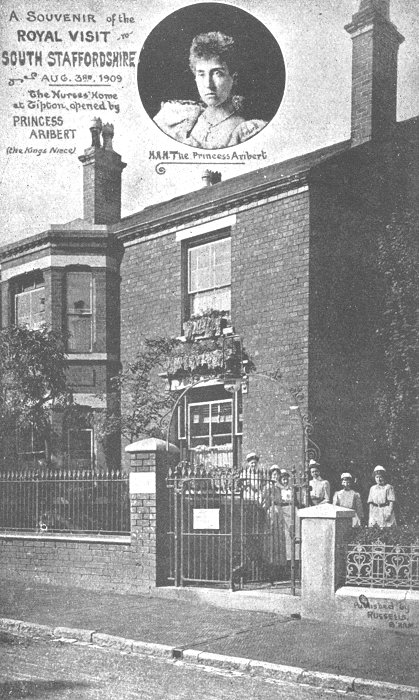|
 |
|
Tipton Urban District Council
produced an annual report on health and hygiene in
the town, which was a good indication of social
conditions at the time. It covered everything from
housing, sanitation, disease and included data from
inspections of working premises, schools and
hospitals. In 1912 the report was produced for the
council by the town's Medical Officer of Health, Dr.
A. S. Underhill.
Housing
The standards of health and
hygiene were not very high. Working class
inhabitants tended to live there for convenience,
being close to their workplace. Upper classes also
lived there because of professional reasons rather
than by choice. Things were improving. In the
previous year, 97 houses had been reported as being
uninhabitable, 49 had been made habitable, 5 had
been demolished and 32 had been given closing orders
by the council. Houses were always available for
working men, at low rents and were generally being
better cared-for than previously. The town’s
mediocre standards of health and hygiene were blamed
on the working class inhabitants.
Domestic sanitation was
described as closet accommodation. Sanitary
conveniences were usually of the closet or cess pit
method with separate accommodation for ashes. Some
excreta was thrown onto neighbouring fields, other
onto tips hired by the council, or loaded onto
covered canal boats and transported to the country
to any farmer who required if for fertilizing his
land. Collection and transportation of human refuse
was carried out by men under the direction of Mr.
Clifton, sanitary inspector. At the time of the
report there were approximately 2,615 privies with
fixed receptacles, 10 with moveable receptacles.
There were 406 fresh water closet receptacles, 6
wash water closets. Mr. Clifton, the sanitary
inspector recommended that fresh water closets
should be connected to the sewers as soon as
possible. He bad noticed that many landlords were
reluctant to do this.
Isolation
Hospital
The isolation hospital stood
alongside the cemetery, at the junction of Horseley
Road and Bridge Road. In the report it is described
as not strictly modern, but had been renovated. It
could accommodate 28 patients, and specialised in
the treatment of scarlet fever, typhoid, and
diphtheria. There were two larger and two smaller
wards. Four beds were set aside for daily admissions
and there was a resident nurse, a caretaker and one
or two casual helpers. It was administered by Tipton
Council’s Cemetery and Hospital Committee. |
|

The location of the
Isolation Hospital. |
|
Disease
During 1912 there were 78
cases of scarlet fever, 11 cases of typhoid, 3
cases of puerperal fever, 13 cases of diphtheria
and membranous croup, 65 cases of pulmonary
tuberculosis, 23 cases of erysipelas, and 1 case
of polio. The cases of scarlet fever came from
the western part of Tipton and 11 of the cases
of diphtheria were in people between the ages of
5 and 25 years. Dr. Underhill regretted that
diphtheria antitoxin could not be freely
supplied to medical men in the area. He also
mentioned that the Tipton area was freer from
tuberculosis than many other districts because
of the towns high elevation, the healthy
occupation of men and the open condition of the
streets and alleyways.
In the previous year there
had been 45 deaths from diarrhoea and enteritis
in infants less than a year old. Dr. Underhill
suggested that this was due to the dusty nature
of the earth in the summer months. The dust
contained decomposed organic matter which was
inhaled by the infants. The death rate due to
diarrhoea and enteritis over the previous five
years was by the standards at the time,
incredibly high: 30 deaths in 1907, 47 deaths in
1908, 26 deaths in 1909, 30 deaths in 1910, 85
deaths in 1911, and 24 deaths in 1912.
In 1912 there were 11 cases
of typhoid, which resulted in 3 deaths. In the
previous five years, deaths from the disease
were as follows: 7 deaths in 1907, 7 deaths in
1908, 5 deaths in 1909, 7 deaths in 1910, and 2
deaths in 1911. There were also 56 cases of
scarlet fever.
In 1912 there was only one
outbreak of measles, confined to one school,
resulting in a single death. Because most
children were affected before they reached the
age of five years and in infants’ schools, they
could not be admitted to the isolation hospital.
If more than 50 percent of children were absent
with the disease in a school, it would be
automatically closed. Dr. Underhill remarked
that a large number of mothers completely
disregarded the need to nurse children sick with
measles. He had on numerous occasions seen small
children covered with the rash running around in
the streets, coming into contact with other
children. He charged working class mothers as
being mostly at fault here. Epidemics of measles
were frequent, as can be seen from the death
rate: 29 deaths in 1907, none in 1908, 21 deaths
in 1909, none in 1910, and 45 in 1911. There had
been previous outbreaks of the disease in 1900
and 1905.
For a period of 12 days,
from April 6th to April 18th, 1912 there were no
deaths and the hospital remained empty. |
|
Schools
Dr. Underhill had 16
schools under his control, 12 were council
schools and 4 were church schools. The school
furniture was regarded as old fashioned and the
ventilation was criticised. He recommended that
it could be improved by a regular and systematic
opening of windows.
Dr. Underhill visited the
pupils in each school twice a year in order to
examine them. He also attended a daily surgery
at his premises in Horseley Road at 10.30 in the
morning to which any child could be sent by his
teacher. During the examinations several
interesting facts came to light. In certain
parts of the town, the quality of the children’s
clothing was poor and in some cases bare feet
would have been better than the shoes that they
wore.
At that time the Tipton
Education Committee felt that it was not an
option to build a schools clinic because
Birmingham and Wolverhampton clinics were easily
accessible.
Schools were sprayed weekly
to combat disease, and district nurses regularly
visited them to examine the heads and general
cleanliness of the pupils. They also gave advice
to the mothers of children with verminous heads,
describing the best methods to keep them clean.
In 1912 the schools
attendance officer reported only one absentee
for blindness and 4 absentees for epilepsy. It
was believed that backwardness in children was
due to epilepsy, but Dr. Underhill stressed that
the cases he came across were, congenital. |

The Nurses' Home, in Lower
Church Lane, opened by Princess Aribert, the
King's niece, on 3rd August, 1909. Also known as
Princess Marie Louise of Schleswig-Holstein.
From an old postcard. |
|
150 children were found to
be infested with vermin. In some cases the child
was sent away from school and not allowed to
return until clean. 1,033 boys and 1,047 girls
had their eyesight tested. 396 boys and 523
girls had perfect sight, but 101 children had
serious eye defects. 3 girls and 10 boys had
serious heart defects. The health of children's
throats was reasonable, but of the 940 boys and
934 girls examined, 113 of each sex had enlarged
tonsils. Dr. Underhill also advised the removal
of adenoids from 58 children.
Most of the children were
well fed. 1,026 cases were found to be fair and
52 were poor. Dr. Underhill was not satisfied
with the condition of the children's teeth. He
had not met a single child who used a toothbrush
and there was not a schools’ dentist.
Food
Most of the food consumed
by locals at the time was hygienic, but had a
low nutritional value. Mr. Clifton, the sanitary
inspector gained a certificate as a qualified
meat inspector, so the inspection of meat was
under his control. The cold meat on sale at
Great Bridge Market, late on Saturday evenings
was described as lacking nutrition, but on
analysis there was no sign of disease. Local
pigs were often inspected by special request and
in many cases found to have a disease. During
1912, 18 tubercular pigs had been condemned as
unfit for human consumption. The 24 local
slaughter houses were found to be generally
clean and serviceable, though most were old and
not up to date.
One of the favourite local
foods was fish and chips but fish frying was
regarded as one of the principle nuisances
because of the heavy fumes produced when frying,
which gave some people much cause for concern.
Dairies, cowsheds and
retail milk shops were visited during the year
by the inspector. All sources of milk supply
were kept under inspection. Dairies and milk
shops were generally found to comply with
standards, but cowsheds were criticised. Some
were ill ventilated and hygienically unfit for
dairy cows. In some cases where ventilating
units had been fitted, they were not used
because it was thought that fresh air diminished
the animals’ milk supply, which was dismissed as
fiction.
The town's water supply,
maintained by the South Staffordshire Water
Company, was praised as being good and
plentiful, the only criticism being its chemical
hardness.
The General
Area
Dr. Underhill’s report
gives a picture of an industrial town which does
not claim to have very high standards of health
and hygiene, but with good standards in many
workplaces, which were generally lofty, not
particularly overcrowded and occasionally
whitewashed.
The population in 1912 was
around 32,000 including a floating population
who moved to the town when work was plentiful
and left when work was not available. In 1912
there were 491 deaths, including 86 people sent
here from other districts. The birth rate was
slightly higher than the previous 10 years,
amounting to 1,143 registered births.
The traditional coal mining
industry was being superseded by a rise in the
number of foundries which created more jobs and
lighter work, such as polishing and assembling.
This was ideal employment for women and was
mainly taken up by younger single girls, who
formerly went into service.
Doctor A. S.
Underhill
Doctor Underhill, Tipton’s
Medical Officer of Health, had an outstanding
career. The Lancet, October 18th, 1890 includes
a report stating that Dr. A. S. Underhill, of
Tipton, was elected as president of the
Birmingham Society of Medical Officers of
Health. It was also reported in ‘Public Health’
January 1926 that Dr. A. S. Underhill was
congratulated for completing 52 years in the
public health service. |
 |
Return to
the
previous page |
|